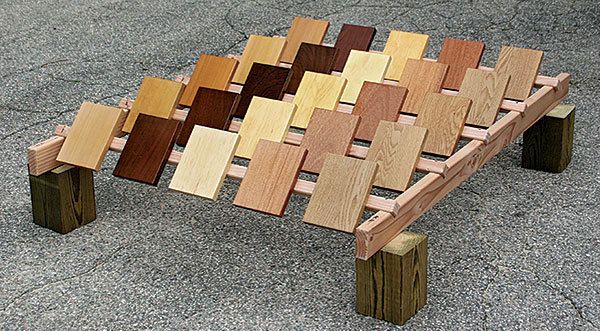Torture Test for Outdoor Finishes
We sent five types around the country and found one favorite
Synopsis: Wood and weather don’t work well together. So if you want to keep that outdoor table or Adirondack chair looking like new, a protective finish is a must. But which finish? They don’t all deliver. To find out, we treated five wood species with five different types of outdoor finish, then let a rack of sample boards sit outside for a year in Oregon, New Mexico, Louisiana, and Connecticut. Each region subjected the samples to a unique set of climate conditions. In the end, we had a new insight on how outdoor finishes and different types of wood hold up to the elements. Read on to discover what we found.
From Fine Woodworking #205
The great outdoors isn’t great for wood. No matter if it’s a fallen maple tree in the back woods or an Adirondack chair in the backyard, nature wants to convert all dead wood into compost.
Sunlight and moisture do a lot to start the process. Sunlight, particularly the ultraviolet (UV) wavelength, causes a chemical degradation in wood. Moisture absorbed by the wood fibers causes them to expand and contract, and that produces surface checks. Then, too, the freezing and thawing cycles common in northern climates can exacerbate the weathering process. Left unfinished, a new piece of furniture can start to look old in a few weeks. In a year, it can look ancient.
So to help outdoor furniture withstand the elements, a protective finish is a must. And if you want to see and enjoy the wood, you’re going to want a clear finish rather than paint.
There are several types of clear finish made for outdoor use. But, as we discovered in a yearlong test, they don’t all deliver. Some offered almost no long-term protection. Others did considerably better. But our test did more than help us find a couple of good outdoor finishes. It also showed us how several different wood species hold up to the weather. And, it gave us new insight into the effect of climate on both finish and wood.
Testing tells the tale: The test evaluated the four types of finish used most often outdoors: penetrating oil, water-based polyurethane, marine spar varnish, and marine extra-UV-filter varnish, plus a combo that one finisher touted in an earlier issue (“A Durable Exterior Finish,” FWW #179), epoxy and marine extra-UV-filter varnish. Also, to see if the wood species made a difference, we applied each finish to five different woods: cedar, ipé, mahogany, pine, and white oak. All, except for pine, are known to hold up to the outdoors better than most. Finally, to see how geography factors in, we ran the test in four regions of the United States with distinctly different climates: the Northeast (Connecticut), Northwest (Oregon), Southwest (New Mexico), and Southeast (Louisiana).
Each wood sample was 3⁄4 in. thick by 6 in. wide by 8 in. long. For consistency, all the samples of each wood came from the same board. And every coat of finish was applied equally to both sides and all edges. Each finish was applied according to the manufacturer’s recommendations shown on the label.
We built four test racks, each designed to hold 25 samples. One rack went up on the flat roof of our Connecticut office building (a perfect out-of-the-way location, we thought, until summer arrived and a colony of hornets built a nest at the trapdoor leading to the roof); the other three went to our regional testers. All the racks were positioned to face south, ensuring maximum exposure to the sun, with the samples tilted at 45° to prevent standing water.
For the full article, download the PDF below:
Fine Woodworking Recommended Products

Osmo Polyx-Oil

Foam Brushes

Waterlox Original






















Log in or create an account to post a comment.
Sign up Log in